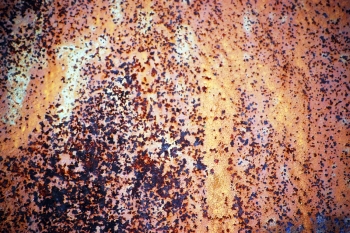Solutions to Questions on Corrosion
Corrosion


Introduction
Corrosion is important topic in the field of Engineering or areas related to it, and we meet it everyday. Its importance makes students whose area of study is related to it to theoretically and practical offer it before leaving the school environment. What is corrosion all about? Corrosion can be defined as unintentional attack on a metal through reaction with the environment. It is a natural phenomenon and almost all metals corrode, or are expected to deteriorate with time.
This piece is on example of questions which fall under corrosion. The answers given are unique and well explained in the sense that any who seeks for help in any of them will feel satisfy after going through them.
1. What are the advantages and disadvantages of E-PH diagram?
Solution to question number 1
Advantages of E-PH diagram
The advantages of potential-PH diagram are as follows:
- It is used in determining the direction of spontaneous reaction that takes place in electrochemical and corrosion cells. It determines the directions of spontaneous reaction when it is in stable or in passive state.
- E-PH diagram is capable of predicting how changes in environment can affect corrosion. This means that the diagram has the ability of detecting at which environmental state corrosion can occur. Whether the environmental change will make the corrosion moderate or not is predictable using E-PH diagram.
- Potential PH diagram determines the estimated nature of corrosion products formed at a specific PH and potentials. If Fe2+ is to be formed when Fe corrodes in water, E-PH diagram is capable of knowing the nature of that product and at a particular PH and the potential it is to occur.
Disadvantages E-PH diagram
As the advantages of E-PH diagram were explained above, there are also its disadvantages or limitations. The disadvantages of Potential PH diagram are as detailed out below:
- Since potential-PH diagram is based on thermodynamic and not kinetic data, it gives no information on corrosion rate. Whether the rate of corrosion will occur rapidly or slowly is undermined by the diagram. The diagram can show the corrosion of Copper in Copper (II) Tetraoxosulphate (VI) without detail on how fast the reaction is likely to take place.
- It does not explain local variations at anode and cathode surfaces. This is one of the major weaknesses of potential-PH diagram.
- A lot of corroding systems in potential-PH diagram produce substances which are not fully identified. It implies that the diagram finds it difficult in explaining and displaying some corrosion reactions. Some reactions that are under corrosion in corrosion cell are not shown by this diagram.
- “Passivity” only indicates the presence of oxides, hydroxides, or other moderate soluble substances, irrespective of their protective properties. A state of passivity is observed in metal when the metal is covered by protective film by moderately soluble compounds and rendered the metal under corrosion rate of negligibly small. This means that apart from oxides, hydroxides, and soluble compounds, E-PH cannot explain passivity of otther compounds.
- The display of equilibrium between metals and their ion, and ions and their corrosion products may be far from equilibrium practically. The way equilibrium is displayed in the diagram is not obtainable in practical equilibrium sense.
Read more on Corrosion
2. Distinguish between activation, concentration, and resistance polarization
Activation Polarization
| Concentration Polarization
| Resistance polarization
|
|---|---|---|
Electrical double layer is formed on the surface of the electrodes caused by absorbed ions and water.
| It takes place at an electrode when the reaction rate is so high that the ions cannot reach the electrode at a sufficient rapid rate.
| It occurs on the surface of an electrode and it is caused by the presence of film which shields the metal from the environment.
|
Some energy must be given up in overcoming barrier before electrochemical reaction can take place.
| The ion concentration in the vicinity of the electrode greatly differs from that of the bulk solution.
| It increases the electrical resistance of the metal involved.
|
It involves activation overpotential, which is the energy required to make a reaction proceed at an appreciable rate.
| Involves limiting current density, which is maximum reaction at which the reacting species can reach the electrode.
| It involves setting up of an additional energy barrier which increases the polarization of the anodic and cathodic processes.
|
The activation overpotential is related to the reaction rate by Tafel equation, given as: ηa = ±βlog (i/i0). Where i is the net current and β is the Tafel slope.
| Concentration polarization is expressed mathematically in the form: ηc = 2.3RT/zF log (1-i/iL)
| Resistance polarization is expressed using an equation: ηR = IR. Where R and I are the film resistance and total current respectively.
|
2b. Outline the polarization kinetics of a metal corroding under anodic, cathodic and mixed control
Solution to question number 2b
The polarization kinetics of a metal corroding under anodic, cathodic and mixed control is explained thus:
- Anodic control: It is a condition where the area of the anode is considerably smaller than the cathode. This happens more during dissolution of passivated metals in dilute acids. Examples of passivated metals in this context are Aluminium and stainless steel.
- Cathodic control: It occurs when the area of the corroding metal cathode is smaller when compared with the anode. This prevails during hydrogen evolution corrosion of Zinc metal, and it has low activation polarization and Hydrogen overpotential on it is very high.
- Mixed control: It is an equal magnitude of both cathodic and anodic polarization and it happens during Hydrogen evolution of Iron and Steel. It explains why corrosion rate of Steel is higher than that of pure Iron.
(3) What do you understand by the term “diffusion control”?
Solution to question number 3
Diffusion control can be explained as the rate at which corrosion of any metal can take place in aqueous solution due to the how soluble Oxygen is to the aqueous solution when the corrosion rate is limited by the diffusion velocity of dissolved Oxygen.
(4) Evaluate the standard electrode potential, E0, for the following reaction:
(i) O2 + 4H + 4e = 2H2O
Take µ of H2O to be -56690 Cal. µ is chemical potential and is measured as free energy per mole.
(ii) O2 + 2H2O + 4e = 4OH-
Take µ of OH- as -37595 Cal. and µ of H2O as -56690 Cal.
(iii) Cu+ + e = Cu
Take µ of Cu+ as 12000 Cal.
Note that F for all the reactions is 96500 Coulombs per gram for all the reactions.
Solution to question number 4
(i) ΔG = µ (products) – µ (reactants)
= - 2*56690 - 0
= -113380 Calories
ΔG is change in Gibbs free energy.
E0 = -ΔG/zF
= -113380 * 4.18/- 4* 96500
= 1.228 Volts
Value of ΔG was multiplied by 4.18 to convert from Calories to Joules.
= 1.228 Volts
(ii) ΔG = µ (products) – µ(reactants)
= (-4 * 37595) – (0 – 56690)
= - 150380 + 56690
= -93690 Calories
E0 = -ΔG/zF
= -93690 * 4.18/- 4 * 96500
= 1.015 Volts
(iii) ΔG = µ (products) – µ(reactants)
= 0-12000
= -12000 calories
E0 = -ΔG/zF
= 12000 * -4.18/96500
= -0. 52 Volts
Note that ΔG= change in Gibbs free energy, z= charge number, while F is the Faraday's number with the value of 96500.
(5) What are forms of corrosion?
Solution to question number 5
Forms or corrosion are:
- General corrosion: This form of corrosion affects the entire surface of the metal. It affects the overall surface of the metal.
- Pitting corrosion: It is a form of corrosion that makes holes on metallic surface to reduce the value of the metal.
- Crevice corrosion: It is a form of corrosion that takes place in the shielded areas of metallic or non-metallic materials.
- Galvanic Corrosion: This corrosion is noticed in galvanic cells for practical purposes. Galvanic cells involve connection between two metals with the passage of electricity as they are immersed in electrolyte.
- Intergranular corrosion: It is a corrosion form in which the metal suffers preferential corrosion along the grain boundaries.
- Corrosion-Fatigue: This corrosion is caused by conjoint action of corrosion and cyclic stresses.
- Cavitational corrosion: It is a form of localized corrosion accompanied by localized damage on the metallic surface.
- Erosion corrosion: This is a localized attack on material associated with turbulent flow.
- Microbial Corrosion: It is a form of corrosion caused by micro-organisms. Most micro-organisms that propagate this corrosion type are sulphur-reducing organisms.
Conclusion
Corrosion as one of the major courses studied by the materials engineering students has reasons for that. Among the major reasons for the study is to detect how the type of corrosion associated with a particular metal can be easily prevented and corrected.
Great job have been done on these questions. The questions are well answered and detailed out. In conclusion the questions and answers provided in the write-up were mainly on diffusion control, standard electrode potential, polarization kinetics of corroding metals, difference between activation, resistance and concentration polarization and on advantages and disadvantages of potential PH diagram, and forms of corrosion.
References
- Elements of Corrosion and Protection Theory by Professor Ijoma
- Materials Science and Engineering by William D Callister, Jnr and David G. Rethwisch.
- Corrosion Engineering: Principles and Practice by Pierre Roberge.
- Fundamentals of Corrosion: Mechanisms, Causes, and Preventive Methods by Philip A. Shweitzer, P. E.










